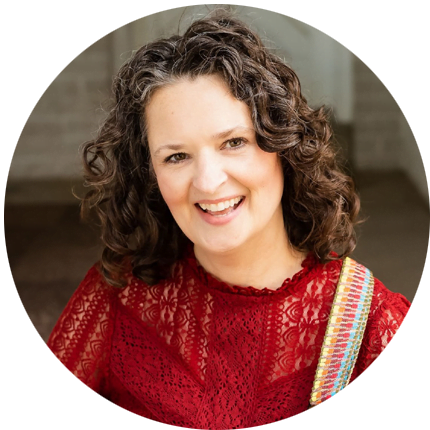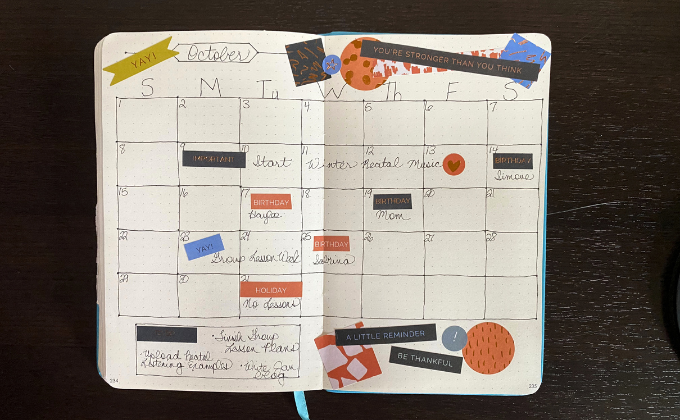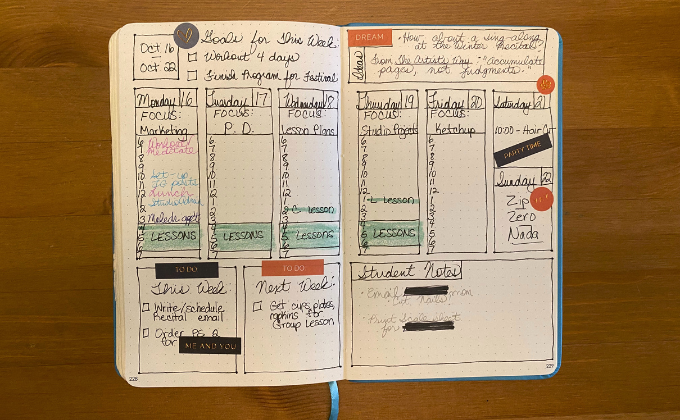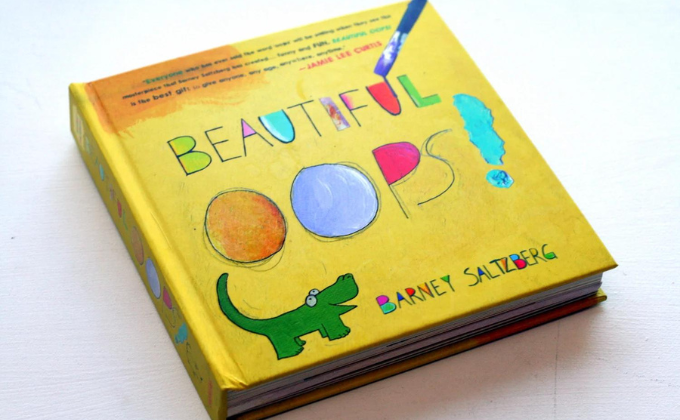
This blog post about the perfect piano teacher planner was written by Carmen Carpenter. Carmen has taught music in a school setting as well as in her home studio for more than 30 years. Teaching combines two of her favourite things: music and kids! Besides teaching music, Carmen loves spending time with family playing games, working puzzles and watching movies. She’s also an avid reader and loves taking long walks on her local, woodsy trails.
Staying organised as a piano teacher and studio business owner can be a real challenge. Using a planner is the obvious way for many teachers to keep on top of all these components of a music teaching studio. But to me, it doesn’t seem like the business-as-usual planner really fits the bill for a piano teacher.

For a long time, I tried to find planners that would help me keep my teaching business, family life and other activities in some semblance of order.
Most of the planners and journals I purchased were singularly focussed on things like appointments, habit tracking or goal-setting. But what I really wanted was a planner that could keep track of all the things that mattered to me: lesson scheduling, family activities, lesson prep, admin etc.
When I finally accepted that all those pre-formatted and manufactured planners didn’t work for me, I did some research and discovered the bullet journal.
What’s a bullet journal, anyway?
A bullet journal is whatever you want it to be: a planner, to-do list, note-taking system, reflection journal, phone and address book, mileage log, shopping list, lending library record, habit tracker, doodle collector and on and on and on.
It’s exactly what you want and need, without any of that other “filler” stuff you often get with other planners.
Whereas you have to conform yourself to pre-made planners, a bullet journal conforms to YOU.
And you don’t have to be artistic or crafty or a planning expert – literally anybody can start a bullet journal.
Why I Prefer a Bullet Journal
Let me tell you why I think the bullet journal is far and above the best type of planner ever for a piano teacher.
Reason No. 1: Build to Suit
As I said, the planners I’ve bought in the past just didn’t fit the way I wanted to plan out my days and weeks.
I love that a bullet journal gives me just the right amount of space to plan my days. Busier days can have more room to write in what I need, and slower days can have a small area on the page.
Not only does the bullet journal act as a planner, it can include any kind of content I want. I can have pages for ideas I’m exploring, notes on professional development or reflection writing.
Reason No. 2: Start Any Time
Isn’t it frustrating that you have to strategically plan when to get a new calendar or dated journal? They always seem to start with January or – if you’re lucky – August (for the new school year).
I agree this is a fairly logical approach. But what if you suddenly decide in October that you want to get yourself in better order?
You’ll waste your money on a dated planner because loads of pages will go unused since you started at an “odd” time.
Reason No. 3: Beautiful Oops
Have you heard of the book Beautiful Oops!? It’s a children’s book about turning your “mistakes” into something beautiful rather than giving up because you think you messed up.
There really aren’t any mistakes in a bullet journal, because you can always use the page you “messed up” for a little art project to cover up the boo boo.
The artwork doesn’t have to be drawn or painted either. (I can’t do either of those things. But if you can, by all means exercise those creative muscles!)
You could cut out pictures from a magazine and make a collage “vision board” of places you’d like to visit or studio decorating ideas. Or use stickers to cover up little blunders.
No matter what, you don’t have to give up on your bullet journal just because it doesn’t look as spectacular as the ones you see on Pinterest or Instagram.
Getting Started
Based on what you might’ve seen on the Internet, bullet journalling can look very difficult and time-consuming. It needn’t be like that. (This really is one of those “if I can do it, anyone can” kind of deals.)
Supplies
You’ll be glad to know you can create a bullet journal with just a pen and a blank or dot-grid notebook. But you should probably keep just a couple things in mind:
- Get pens with ink that won’t bleed through the pages of your notebook. (These pens are a favourite for many journallers.)
- Look for journals with 120gsm pages so you can’t see straight through cheap, flimsy paper.
- It’s nice if the journal has numbered pages, but not mandatory. You can always do that by hand as you go along.
- Highlighters can be handy. (I like gel highlighters because they won’t bleed through the pages.)
- If you really want to get fancy with it, stickers are fun for marking special days and covering up boo-boos.

You can break the bank on buying bullet-journalling supplies, so don’t go too crazy right out of the gate. It’s amazing what you can do with a page full of dots and a good ol’ ball point pen.
The Set Up
One of the things I love about bullet journalling is that you don’t have to know right away how you want to arrange things. Your journal can actually be an ever-evolving project.
Even so, there are a few steps you’ll need to take to get the ball rolling.
- Number the pages. (Unless, of course, you took my earlier advice and got the notebook with numbered pages. 🙌)
- Make a title page. This needn’t be anything other than your name. But if you want to name it something like “Carmen’s Courageous Effort at Keeping Her Life Organised”, feel free. 😆
- Create a table of contents by reserving a few pages at the front of the journal so you can fill in later what pages have what things.
Organisation Central
Now that you have the prep stuff out of the way, it’s time to get busy creating pages that will suit your particular organisation needs and planning style.
While a bullet journal can have whatever you want in it, I’ve found these 3 basic types of pages to be useful in a piano teacher planner.
Basic Page 1: A Year in the Life
This may sound like I want you to put a whole year of pages in your bullet journal. Please don’t do that! You may find that you don’t like the format or style of those later, and I don’t want you to be frustrated by that.
- Take 1 or 2 pages after the Table of Contents to create a yearly timeline with a rough sketch of how you imagine the year is going to play out.
- Include big events such as recitals, exams, contests etc., plus anything else you might need to do long-range planning for.
You don’t have to start your journal in January or August. Just make your year start from your starting place – even if it’s 17 October.
Basic Page 2: Month At-a-Glance
I like to keep this page nice and simple – just enough so I can see the month all at once. My monthly calendar is just a grid of boxes spread over 2 pages.

Don’t worry about writing your whole schedule on this page. It’s mainly a way to see the days and weeks – not to keep track of your teaching schedule or other regular occurrences. (That’s what the other pages will be for.)
Your monthly calendar should include things like group lessons, studio themes or content-focus areas so you can see what’s happening all at the same time.
Basic Page 3: Weekly/Daily Pages
For me, this is where the magic really happens. These are the pages I use to keep track of everything from my teaching schedule to appointments to my to-do lists.
Pro tip: Don’t do a whole year’s worth of weekly pages at the very start of your journal. Create one week at a time so you can experiment with different formats and find the one that works for you.

Here are some things to try:
- If your days are packed with lots of different activities, build a 3- or 4-page spread for the week with large spaces for each day so you can include reminders, notes and tasks.
- A 1- or 2-page weekly layout will be sufficient if your schedule is basically the same each day. Then just write in the highlights of appointments and other items to remember.
- At the top of your weekly pages, make space to jot down personal and studio goals you’d like to attain for the week.
- Give each day of the week a focus. For example: Mondays for marketing tasks, Tuesdays for professional development, Wednesdays for planning, etc. and write that at the top of that day’s box.
- On the bottom of the page, make a place to write things to do the following week. That way, you can begin to make preparations or at least keep those things top of mind.
The Other Pages
The great thing about a bullet journal is you can create a page about literally anything you want.
- Reflection pages can help you remember what you taught or the direction you want to take with specific students.
- Idea pages are great for writing down all those marvellous thoughts you have in the wee hours of the morning.
- Notes pages might hold useful nuggets about professional development, reading or even music you want to buy.
As you can see, there are no limits to the kinds of pages you can create for your journal.
New Year’s Resolutions can be a great thing to track in your bullet journal. Not sure how to set resolutions you can actually keep? Nicola and the gang will send you a list of 31 great ideas when you enter your info below.

Subscribe to updates and get the 31 Achievable New Years Resolutions for Piano Teachers
Enter your details to subscribe to the newsletter for piano teachers with information, tips and offers.
I hate spam as much as you do! I’ll only send you information that’s directly relevant to music teachers and you can unsubscribe at any time.
VMT members can download the list from the exclusive VMT Printable library. Not a member? See what all the hype is about at vibrantmusicteaching.com.
Maintaining Your Bullet Journal
As with anything new in life, it can be challenging to keep up your bullet-journalling habit. Here are a few tips and tricks.
- Once a week, reserve time to sit down and build your pages for the coming week. (If this seems to take a long time at the beginning, don’t worry. The process will get faster and easier the more you do it.)
- Add the titles and page numbers to the Table of Contents as you fill things in.
- Above all, go easy on yourself. This is your journal. No one else need ever see it, so make it as fancy or as simple as you like.

What’s your favourite method of piano teacher planner?
I’d love to hear your preference, along with your thoughts about bullet journalling, in the comments below.
If you found this article helpful, Nicola has a centralised hub page with the latest-and-greatest must-see resources for running your music teaching studio business. Check it out today and bookmark it for easy reference when you need it down the road.
